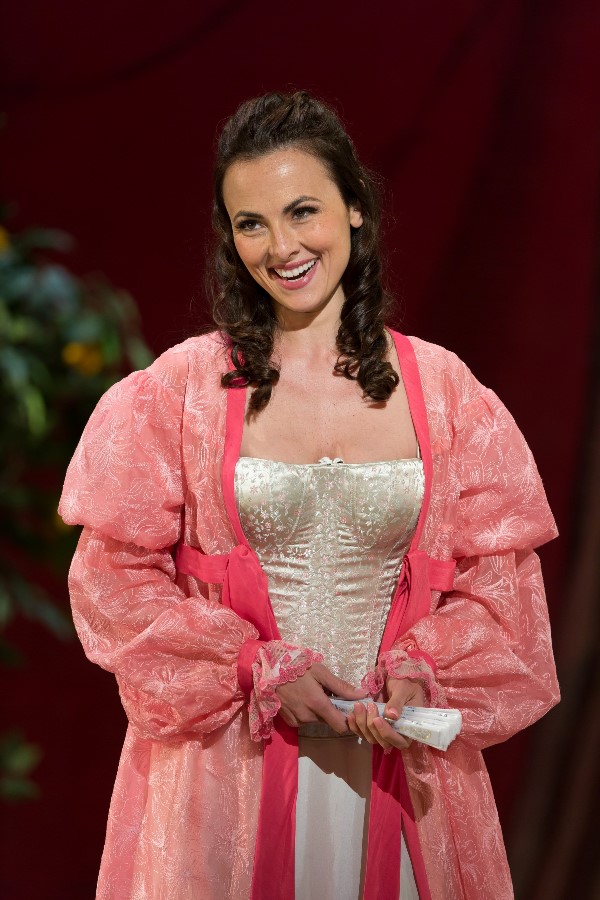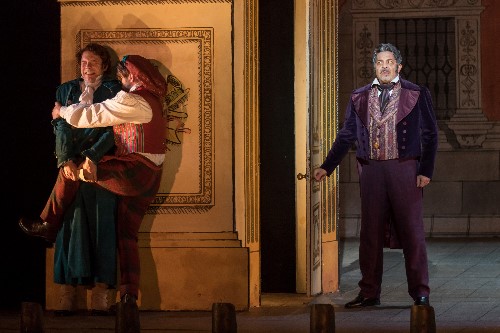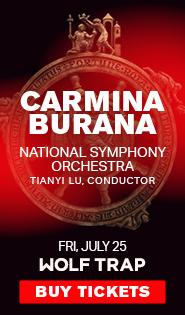Washington National Opera opens zany “Barber of Seville”

Isabel Leonard as Rosina in WNO’s The Barber of Seville. Photo: Scott Suchman.
Rossini’s The Barber of Seville is every opera company’s bread and butter, a screwball comedy with brilliant music. Washington National Opera opened a new production on Saturday in the Kennedy Center Opera House, its first staging of this evergreen opera buffa since 2009. The evening boasts an excellent cast and a production that poses interesting questions while likely still pleasing traditionalists with its eye-catching costumes and Spanish color.
It reunited a pair of singers from the company’s staging of the same composer’s La Cenerentola from 2015. Isabel Leonard made a feisty, comely Rosina, her snappy repartee supported by incisive comic timing. The American mezzo-soprano’s voice has broadened and warmed considerably, filling out in volume and smoothing over the chinks in the many florid runs. She could certainly have extended the decorative fill added to the part, but the high notes and other effects were solid.
Buffo baritone Paolo Bordogna’s antics, which overwhelmed his role in La Cenerentola, were a major asset for his Doctor Bartolo. Intonation and stability of tone wavered in some of the more straight singing, but Bordogna drew out every hilarious element of the character’s pompous, blustering silliness. He peppered the patter of his recitative with growls, sighs, absurd sound effects, and wild gesticulation to superb effect.
Two outstanding company debuts further enhanced the evening, beginning with the American debut of Moldovan baritone Andrey Zhilikhovsky in the title role. His Figaro strode through the audience with confidence for his famous entrance aria, crowned with beautifully placed and puissant top notes and tripping diction in the fast sections, at times slightly rushed but exciting.
Ohio-born Taylor Stayton’s Almaviva was handsome and lyrical, a light tenor with floated high notes and distinct, slightly forced runs. The highlights of his performance were not necessarily the vocal showpieces: no restoration of the character’s demanding Act II aria “Cessa di più resistere” here, as Lawrence Brownlee did in 2009. Stayton excelled instead in his comic disguises, as a drunken and belligerent soldier and a prancing, lisping music teacher.
Former Domingo-Cafritz Young Artist Wei Wu brought magnificent vocal force to the role of Don Basilio, with a potent crescendo powering the aria “La calunnia è un venticello.” What was less expected was his comic ability, as he hammed and mugged his way through his scenes. Soprano Alexandria Shiner, currently in the Domingo-Cafritz Young Artist program, had a standout night as the servant Berta, laser-focused and with admirable power in her single aria in Act II.

Tenor Taylor Stayton (Almaviva), Baritone Andrey Zhilikhovsky (Figaro), Bass Paolo Bordogna (Bartolo). Photo: Scott Suchman.
The debut that was less spectacular was conductor Emily Senturia at the podium, stepping in to replace Maurizio Benini, who withdrew from the production because of a family emergency. She was capable and calm at the helm, but a number of elements seemed to slip out of control, not least the tendency of the WNO Chorus to rush ahead of her downbeat. With a clear head and gestures she resolved these issues, but the sparkle of the score did not quite ignite as it should.
Director Peter Kazaras has updated the action of the opera from the 17th century to around the time of the opera’s premiere in 1816. The police that intervene in the brilliant Act I finale are costumed in uniforms like those of the army of Napoleon (costumes by James Scott), who had just been deposed the previous year.
A proscenium arch frames the stage, making a stage within a stage, perhaps recalling the Teatro Argentina in Rome, where the opera was premiered. A theater box is even visible, painted on the inside of the arch, and a row of lights tilt upward at the apron. The sets, designed by Allen Moyer, are painted in an artificial style but with an ingenious way to show both the interior and exterior of Bartolo’s house.
Kazaras has emphasized the role of Figaro as puppet master—or, perhaps, stage director—controlling the actions of the other characters most literally in the Act I finale, where they become like marionettes or automatons. With the soldiers gyrating in time to show-choir choreography, directed by Rosa Mercedes, the scene became like one of those complex automaton clocks featuring the robotic movements of many components. It was not the only time the fourth wall separating the stage within the stage from the house was broken.
The Barber of Seville runs through May 19 at Washington National Opera. A different cast, featuring members of the Domingo-Cafritz Young Artist program, performs on May 17 only. kennedy-center.org; 202-467-4600.


